Table Of Contents
- 1. Creating Lower-Barrier-to-Entry SME Videos
- 2. Animating Text to Make Information More Scroll-Stopping
- 3. Hopping On Pop Culture Trends
- 4. Boosting Poll Engagement with Simple, Personal Questions
- 5. Promoting Blog Posts Via PDF Carousels
- 6. Promoting Company Culture Via Employee Interviews
- 7. Producing Short Product Videos
- 8. Getting the Field Team Involved In Sharing Customer Stories
- Now It’s Time To Run Wild! (Or, You Can Leave That To Us)
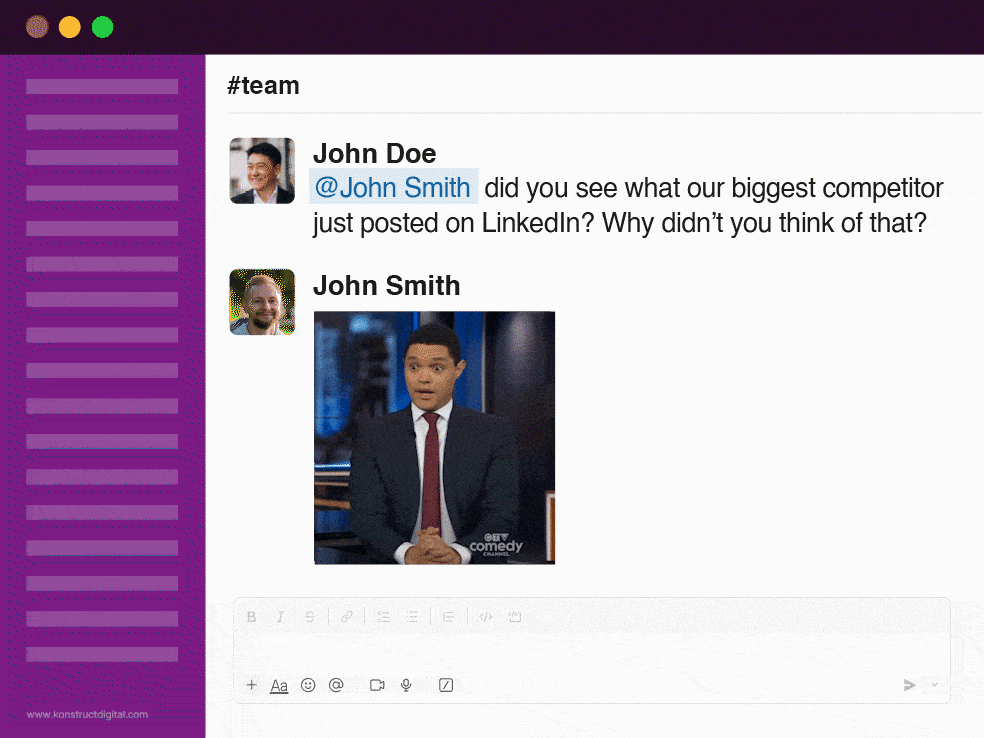
Publishing weak B2B LinkedIn content while your competitor is spitting out marketing gold is like being the team’s benchwarmer compared to the all-star.
Sure, you showed up and put your jersey on but… maybe you could’ve just stayed home…
Sorry to any wannabe child athletes I just offended! Surely, somebody has to cheer on the A-players from the sidelines!
To be fair, there are PLENTY of obstacles that get in the way of great B2B LinkedIn content.
First and foremost on this list are busy SMEs.
They hold all the insights you need to produce valuable content for your audience, and yet… trying to get them to care about your LinkedIn marketing initiatives, let alone support them, can be like trying to pin down a cat to clip their claws.
As an owner of two cat babies and a person who spends a good chunk of her time trying to pin down SMEs to soak up all of their wisdom, I can sympathize with both struggles.
Then there’s the infinite content abyss and the fatigue caused by information overload—especially when that information is dull and overly promotional.
Raise your hand if you’ve ever been personally victimized by a draining LinkedIn newsfeed.
Finally, a lot of SMMs just lack assets to work with. We all know that great creative is the key to unlocking engagement and getting people interested in your brand, but what are you supposed to do when great creative is hard to come by?
The thing is, some B2B companies do seem to overcome these challenges to produce truly stellar LinkedIn posts that make LinkedIn members excited to follow their brands.
So, how do they do that?
Well, for the past year, my team of content specialists has been meeting on a monthly basis to discuss just that.
We come together each month and share the best LinkedIn B2B marketing examples we’ve seen over the previous few weeks, specifically, the ones that made us say, “$h!t, I wish I thought of that!”
Instead of sulking over missed opportunities, we’ve taken inspiration from these examples and applied them to the LinkedIn content we produce for our clients.
And, today’s your lucky day because I’m taking some of the insights we’ve gained from that year-long exercise and I’m sharing them with you here!
Steal the strategies used in the following LinkedIn B2B marketing examples to level up your LinkedIn marketing strategy like we did!
1. Creating Lower-Barrier-to-Entry SME Videos
We’ve already talked about how the SMEs at your organization are the gatekeepers of the valuable insights you need to impress your LinkedIn audience.
However, as I mentioned, SMEs can be hard to pin down.
The best thought leaders at your organization tend to be the ones with the heaviest workloads and/or the fullest calendars.
And then there’s the added layer of asking them to speak on camera… Cameraphobia is #real!
Well, here’s a genius idea from Sullair on how to make the process of videotaping a thought leader as simple and stress-free as possible.
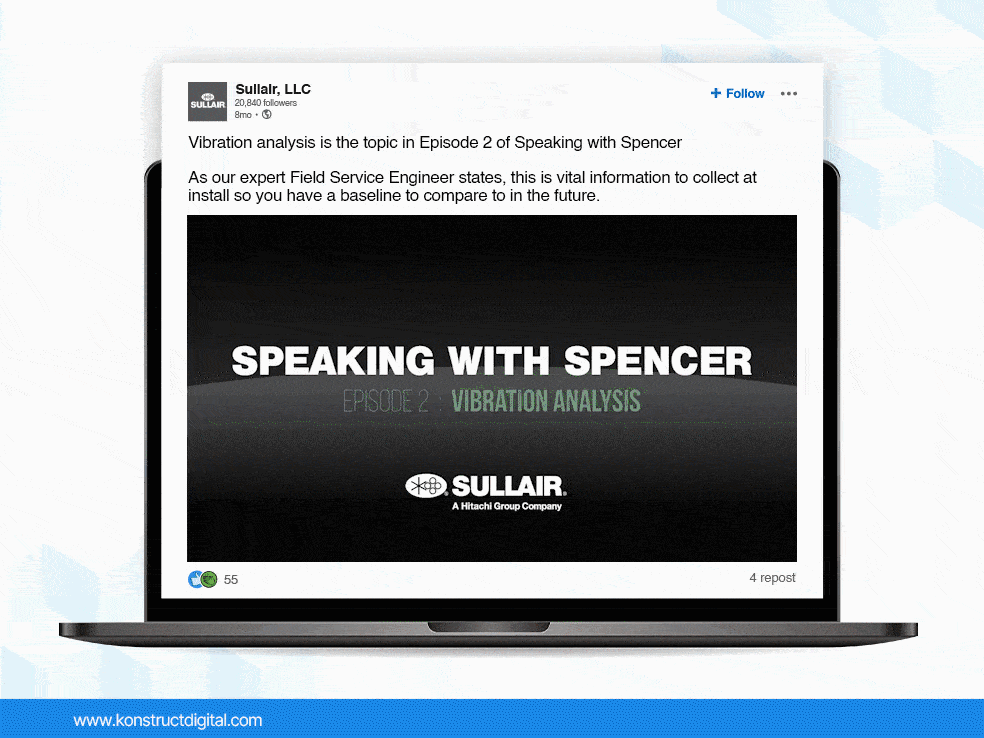
Source: Sullair
I’m not saying to book a meeting with an SME and ambush them with the idea of recording the call, but I’m not not saying that either…
…Kidding!
But, in our experience, recording a Zoom video can help mitigate camera shyness and make the perceived chore of sitting down to record a video feel less burdensome and time-consuming.
Take away all of the professional video equipment and blinding lights and let your SMEs share their thought leadership in a place where they feel comfortable and confident.
Also, even if you’ve got all the budget in the world to produce high-production videos, sometimes a low-budget, casual video like this will perform better.
The video doesn’t need to be long either to be a high-value post for your company page. In the age of shorter and shorter attention spans, short videos are more likely to be watched in their entirety.
2. Animating Text to Make Information More Scroll-stopping
There are plenty of stats that suggest video content performs better than other forms of creative on LinkedIn. For example, Sprout Social reported that “Video gets 5X more engagement on LinkedIn.”
To be fair, this isn’t specifically a B2B metric. But, from my experience analyzing the performance of thousands of LinkedIn posts for our B2B clients, I can tell you that videos and GIFs typically do receive more engagement than static image-based posts. It all depends on the subject matter of said video or GIF though, of course.
Videos tend to stand out in LinkedIn feeds because the movement catches people’s eyes and stops the scroll.
However, despite it being practically public knowledge that videos are more engaging than static images on the LinkedIn platform, many B2B businesses—specifically more abstract B2B businesses like those in cloud computing, for example—shy away from videos because they don’t know what to film.
Well, you don’t actually have to film anything to produce engaging video content.
The following post from Deloitte is a great example of this point:
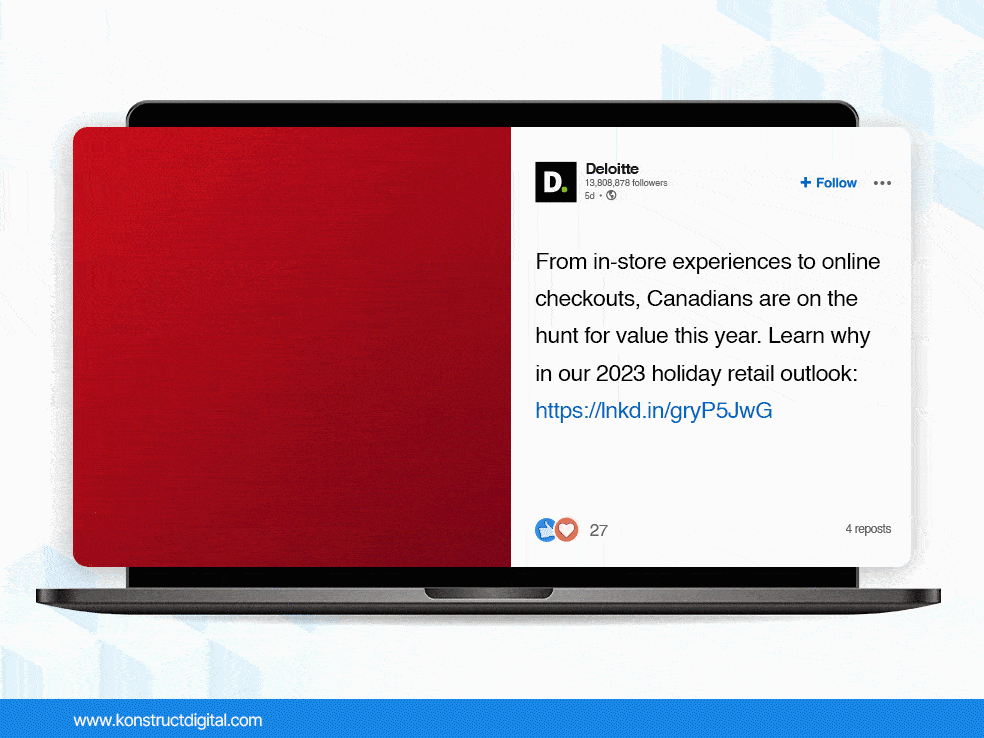
Source: Deloitte
Is this the most creative, innovative LinkedIn post I’ve ever seen? No.
BUT, it got my team thinking about the fact that although video content is often seen as this significant, out-of-reach investment, it doesn’t have to be.
Simply animating some text that provides interesting information for your audience can be enough to catch their attention and get them to engage with and make a mental note of your brand.
3. Hopping on Pop Culture Trends
The following might be a hot take, but I’m willing to stir the pot.
Pop culture references aren’t just for B2C social media marketing.
The following LinkedIn post from HubSpot is one of the most genius nuggets of B2B marketing gold that I’ve ever witnessed.
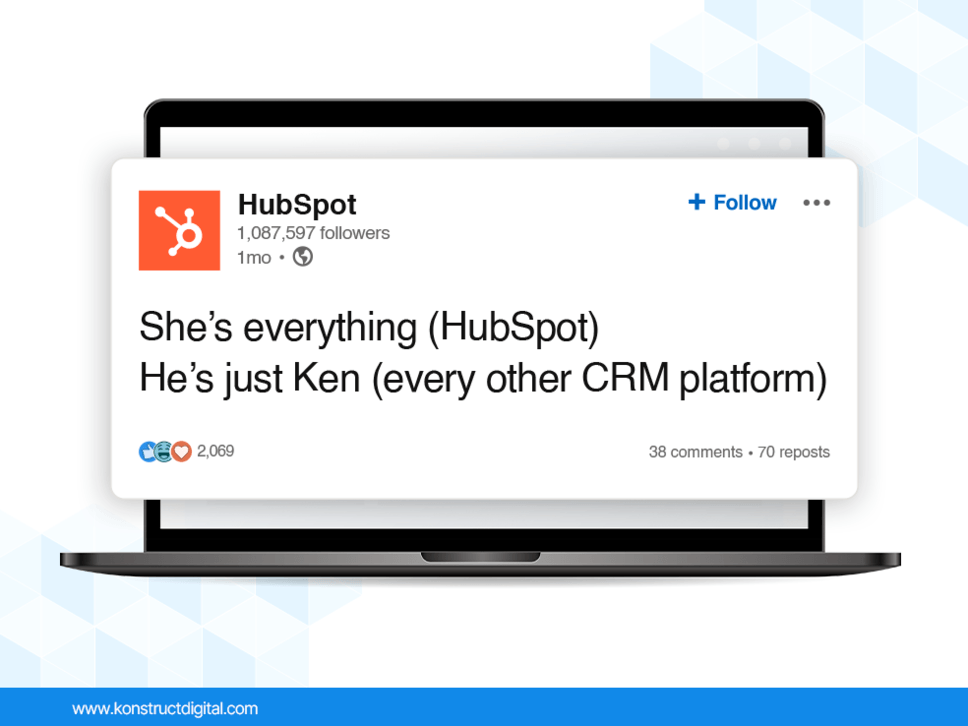
Source: HubSpot
If you just rolled your eyes and thought, “That would never work for my brand,” hear me out.
Here’s why I think this post is so epic:
- HubSpot published this post right on the heels of the Barbie movie premier.
- Barbie was one of, if not the top-trending topic at the time, especially with women in their 20s.
- What demographic makes up a large percentage of social media marketers? Women in their 20s.
HubSpot excels at social media marketing, not only on LinkedIn but on other social media platforms as well, because they have an acute awareness of their audience and what that audience cares about.
In other words, I’m not saying that an industrial manufacturing business would have had the same success with a Barbie movie reference.
But, I am saying that knowing your audience inside and out and capitalizing on the trending topics that your audience cares about (and that you can tie back to your business) could prove to be very lucrative.
4. Boosting Poll Engagement with Simple, Personal Questions
LinkedIn polls are like the cookies at the farmer’s market that look delicious before you bite into one and it’s dry and tastes like dust.
(I don’t know if this is a relatable experience, but I have terrible luck with farmer’s market cookies and I’m tired of being swindled!)
Anyways, what I mean to say is that LinkedIn polls seem like an intriguing opportunity to engage with your audience until you publish one and it completely flops.
Then, since LinkedIn has no mercy, you’re stuck with the pitiful size of your voting pool displayed on your closed poll for all of your followers to see.
So, how do certain businesses manage to get thousands of people to vote in their polls while others get none?
Follower count aside, we’ve noticed that it comes down to a few factors:
- Polls need to intrigue LinkedIn users enough that they are curious about how other people answered the question. The only way they can see other people’s answers is to vote in the poll themselves (unless the poll is closed, obviously).
- Polls need to ask for information that your audience wants to share.
Here’s a great example from Flowserve of the latter:
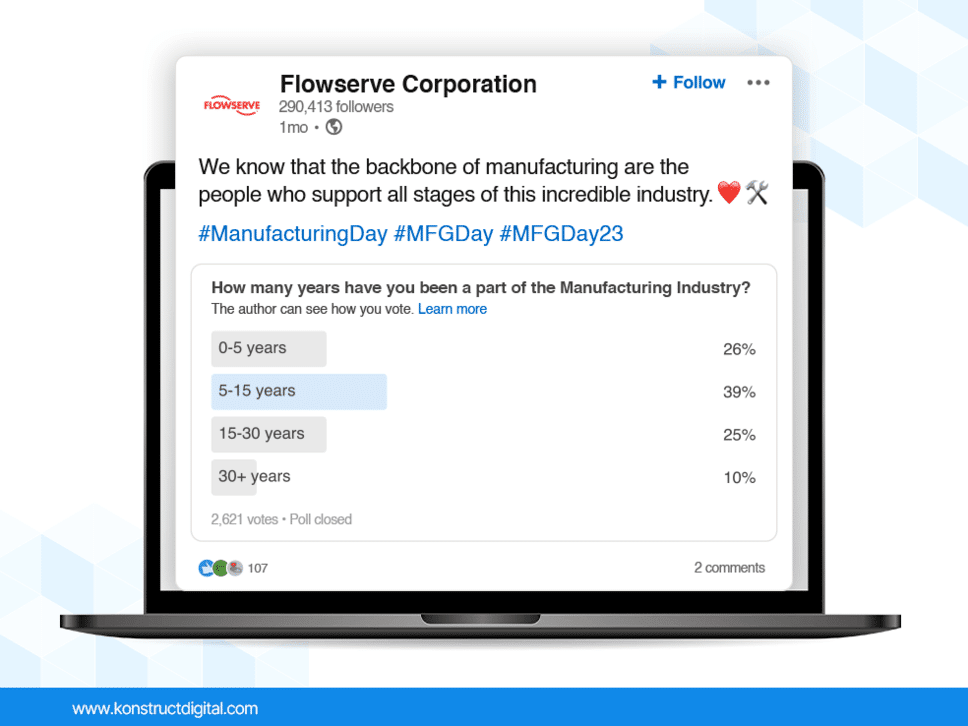
Source: Flowserve Corporation
This poll is great because it encourages people to share information that they are proud of on a day that is meant to celebrate them.
It appeals to one of Flowserve’s target markets and the good feelings that it elicited from poll participants were then tied to the Flowserve brand.
To be candid, we’ve experimented with a lot of polls for our clients and ourselves. The ones that failed were the ones that put our audience on the defensive. For example, we would ask something along the lines of “What was your biggest marketing struggle this year?”
Polls like this seem like a good idea in theory but they don’t make an audience excited to answer the question. Polls that make your audience feel good about themselves outperform those that ask your audience to be introspective and admit to faults.
You live and you learn, right?
5. Promoting Blog Posts Via PDF Carousels
PDF carousels are all the rage in the LinkedIn marketing influencer realm.
You’ve probably come across these posts in your newsfeed.
The cover typically has a catchy hook followed by pages and pages of short content snippets.
They’re akin to a bite-sized e-book.
I hypothesize that the reason these posts are so successful is the same reason why it’s a best practice to break blog content up into ultra-short paragraphs.
Smaller snippets of content trick your brain into thinking the content is less burdensome to digest.
Don’t get me wrong, people want high-value content. They just don’t want to strain their brains to get that value.
There’s often a perception that B2B audiences have more patience than B2C audiences. While there is truth to this idea when B2B audiences are searching for specific information, it’s not necessarily the case when they are confronted with information that they weren’t looking for.
Your job is to convince your audience why they should care and keep them hooked with a low perceived investment on their part.
Here’s an example of a PDF carousel that we’ve published to test out this LinkedIn strategy with our B2B audience:
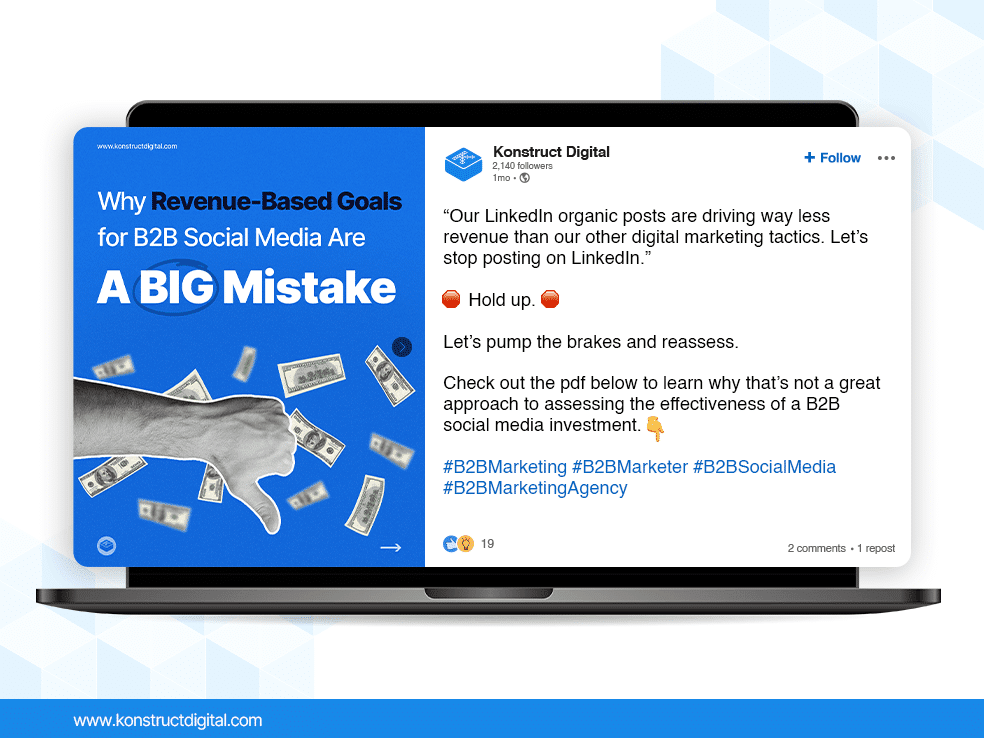
Source: Konstruct Digital
We’ve also played around with using PDF carousels to share interesting tidbits from a recent blog post to drive traffic to the article.
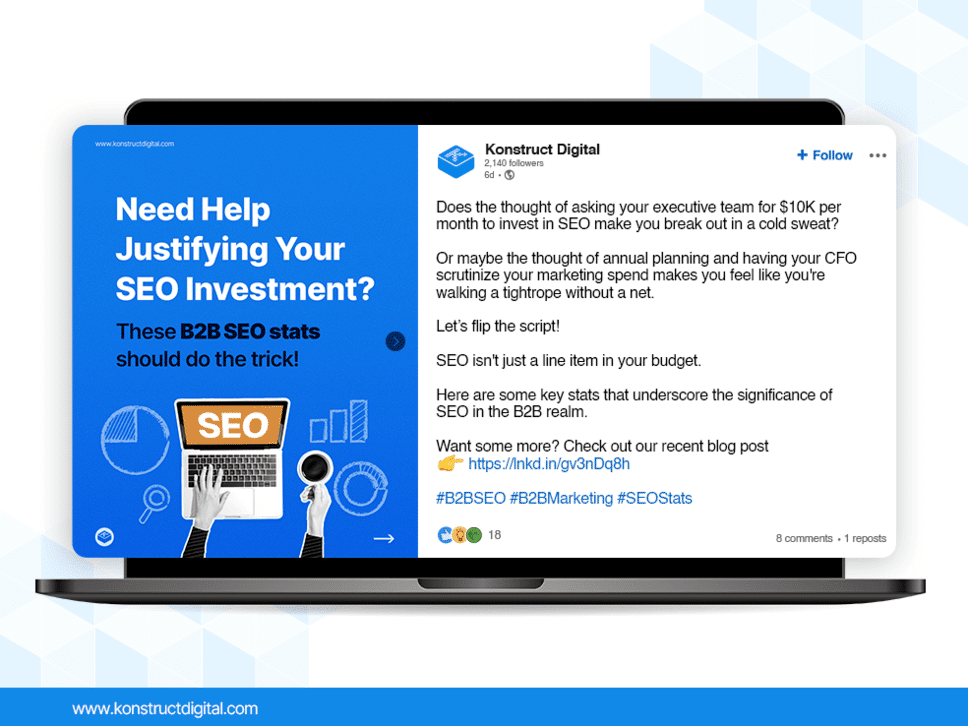
Source: Konstruct Digital
The key here is to give just enough information away that your audience is bought in and wants more, without giving away all the good stuff and making it pointless to click through to your blog post.
6. Promoting Company Culture Via Employee Interviews
There’s practically no better click magnet for a B2B business than a photo of a smiling employee.
Sure people appreciate LinkedIn content that provides value, but brand loyalty is built by sharing the real people behind a brand.
You can’t post random employee photos just for funsies, though.
These post still needs to have a purpose and a strategy.
There are a few obvious ways that you can get more smiling faces on your company’s LinkedIn profile:
- You can share photos from company events.
- You can post about employee anniversaries.
- You can congratulate employees on their promotions.
All of the above are good ways to increase engagement and followers on your company page. The last two are especially beneficial because employees featured in these posts are more likely to share the posts with their professional network, exposing your brand to a larger audience.
But, outside of the above ideas, how else can you produce valuable content that features your employees?
I know I already shared an example from Deloitte, but I think they really struck gold with the following post:
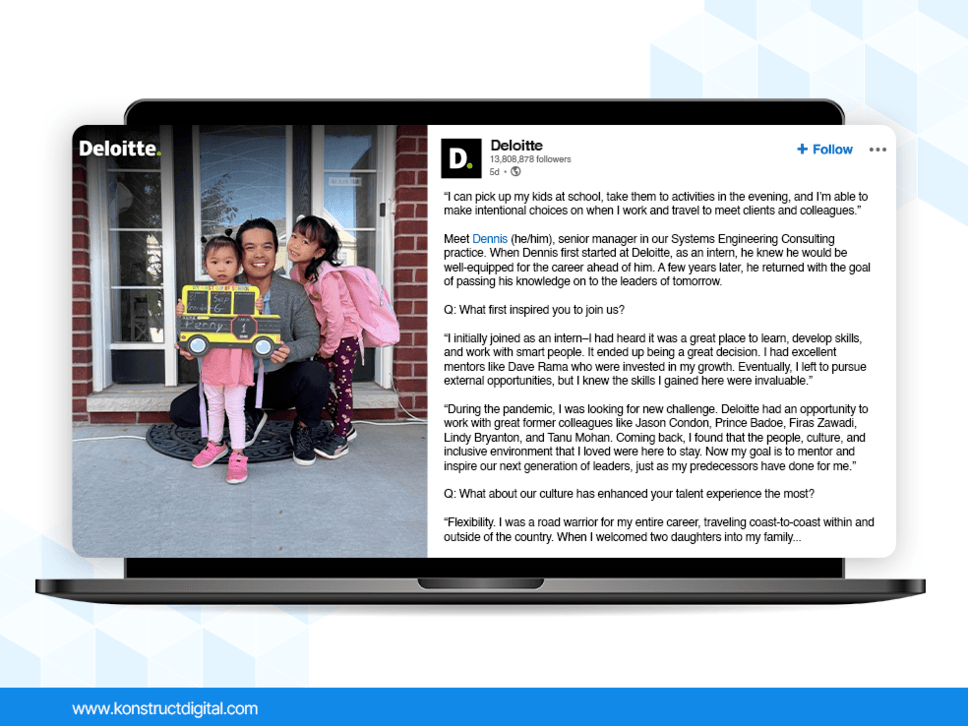
Source: Deloitte
I love the idea of interviewing a brand champion at your organization and making the caption the transcript of said interview.
By “brand champion”, I mean someone who can speak to your brand message particularly well.
We already talked about the fact that it can be tough to get people in front of the camera for a video. This idea removes that barrier entirely while still allowing you to leverage the voice of the employee.
7. Producing Short Product Videos
This idea is so seemingly obvious that I almost didn’t include it.
Product demonstration videos are practically cliché in the B2C space but, for whatever reason, I don’t come by them often from B2B businesses.
I’m not saying to go the cheesy infomercial route—although if done, well that could be hilarious for a piece of heavy-duty machinery, for example—but even simple low-budget video content that demonstrates the ease of use of your product could be a highly valuable sales tool.
Here’s a great example from AmeriGlobe LLC that demonstrates just how simple these videos can be, while still being highly impactful.
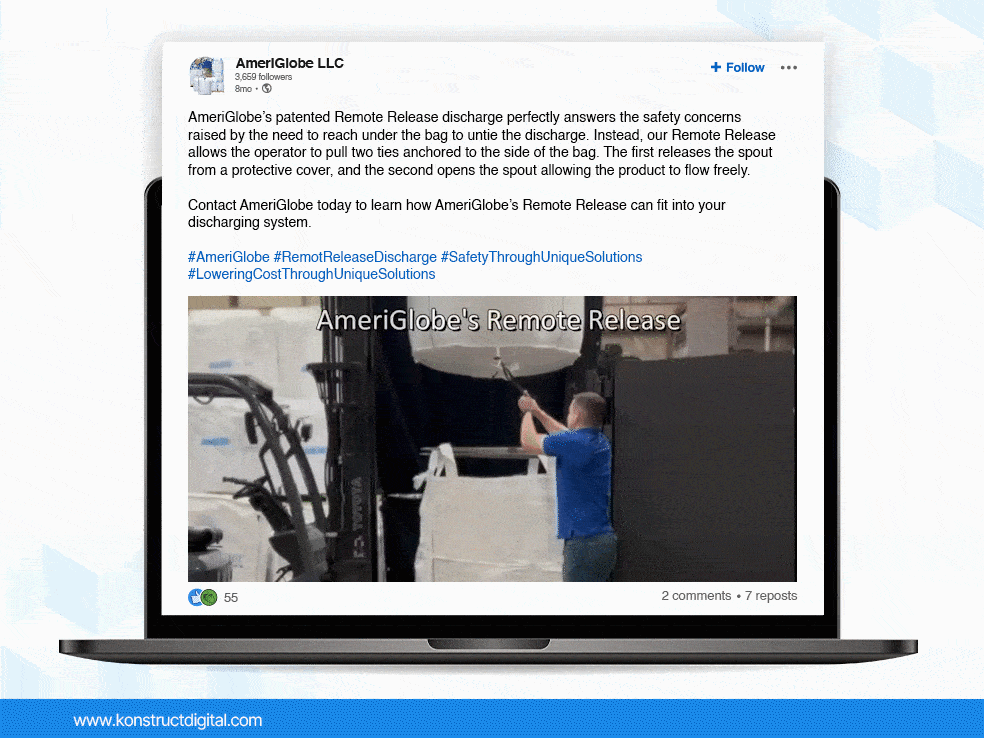
Source: AmeriGlobe LLC
8. Getting the Field Team Involved in Sharing Customer Stories
Finally, I’m ending this article with a little more shameless self-promo.
Before you scroll away, this is one of the best strategies we’ve implemented across all of our B2B clients, and it consistently results in high engagement for our clients.
Here’s how it works:
Our client, Chamco, has service technicians and an in-house engineering and design team that were constantly driving impressive wins for their customers but they didn’t have a process in place for sharing those wins with the public.
We helped Chamco set up a system where their employees could submit customer stories directly to our content team to be rewritten and shared on LinkedIn.
In order to incentivize Chamco employees to submit content, Chamco rewards the employee who submits the best story each month with a restaurant gift certificate.
If you’re curious about the results of this strategy, you can read more about it here.
Otherwise, here is an example of a LinkedIn post we produced based on a submission from one of Chamco’s technicians.
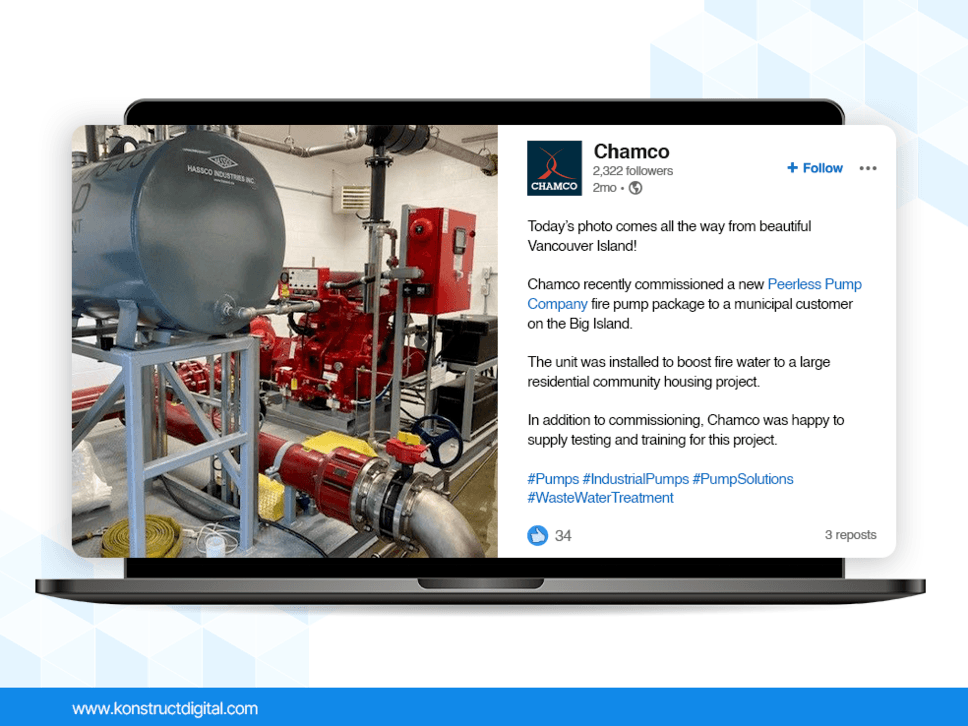
Source: Chamco
Chamco’s customer story LinkedIn posts serve as a fantastic source of social proof and make it easy for our team to show off Chamco’s expertise to their potential customers.
Now It’s Time to Run Wild! (or, You Can Leave That to Us)
Well, there you have it! Reading this article was like being a fly on the wall of a Konstruct Social Media Inspiration Session.
I hope these brilliant LinkedIn B2B marketing examples left you feeling inspired and ready to tackle new LinkedIn strategies for your business.
If these strategies all sound great but feel a little overwhelming, that’s okay too.
My team’s entire job is to live and breathe B2B content. We spend 8 hours a day writing and analyzing it only to go home and think about it on our drive home, in the shower, and sometimes even in our dreams!
If content marketing isn’t the entire scope of your job, it’s hard to keep up with all the new trends and LinkedIn algorithm updates.
So, if you need someone to take on that burden for you, we’re here to help!
Request a proposal to learn more about how our LinkedIn marketing solutions can support your marketing efforts and business goals.
Need help with B2B Content?
Learn more about Konstruct's B2B Content Services
More B2B Content Resources
- Should You Replace Your Content Marketer with AI? Maybe…
- 9 B2B Social Media Dos and Don’ts That’ll Change Your Social Game
- Stop Snoozing on These 7 B2B Content Marketing Trends
- B2B Marketing Copywriting: 10 Tips for Writing Persuasive Copy for Today’s B2B Buyers
- 9 Wow-Worthy B2B Content Marketing Examples To Inspire Your Content Strategy
- 8 Irrefutable B2B Social Media Marketing Benefits
- The Proven Formula for a Rock-Solid LinkedIn Content Strategy
- Content Marketing Statistics: The Facts You Can’t Afford to Ignore
- 999,999 Tips for Creating On-Brand SEO Content
- 6 Brands That Are Killing it on TikTok


